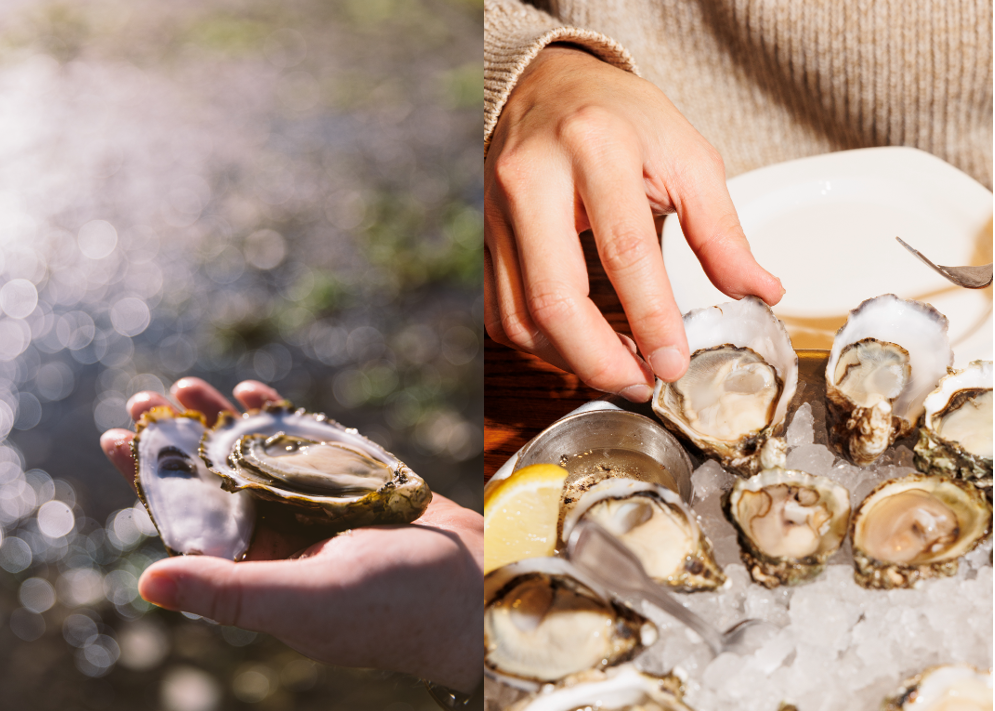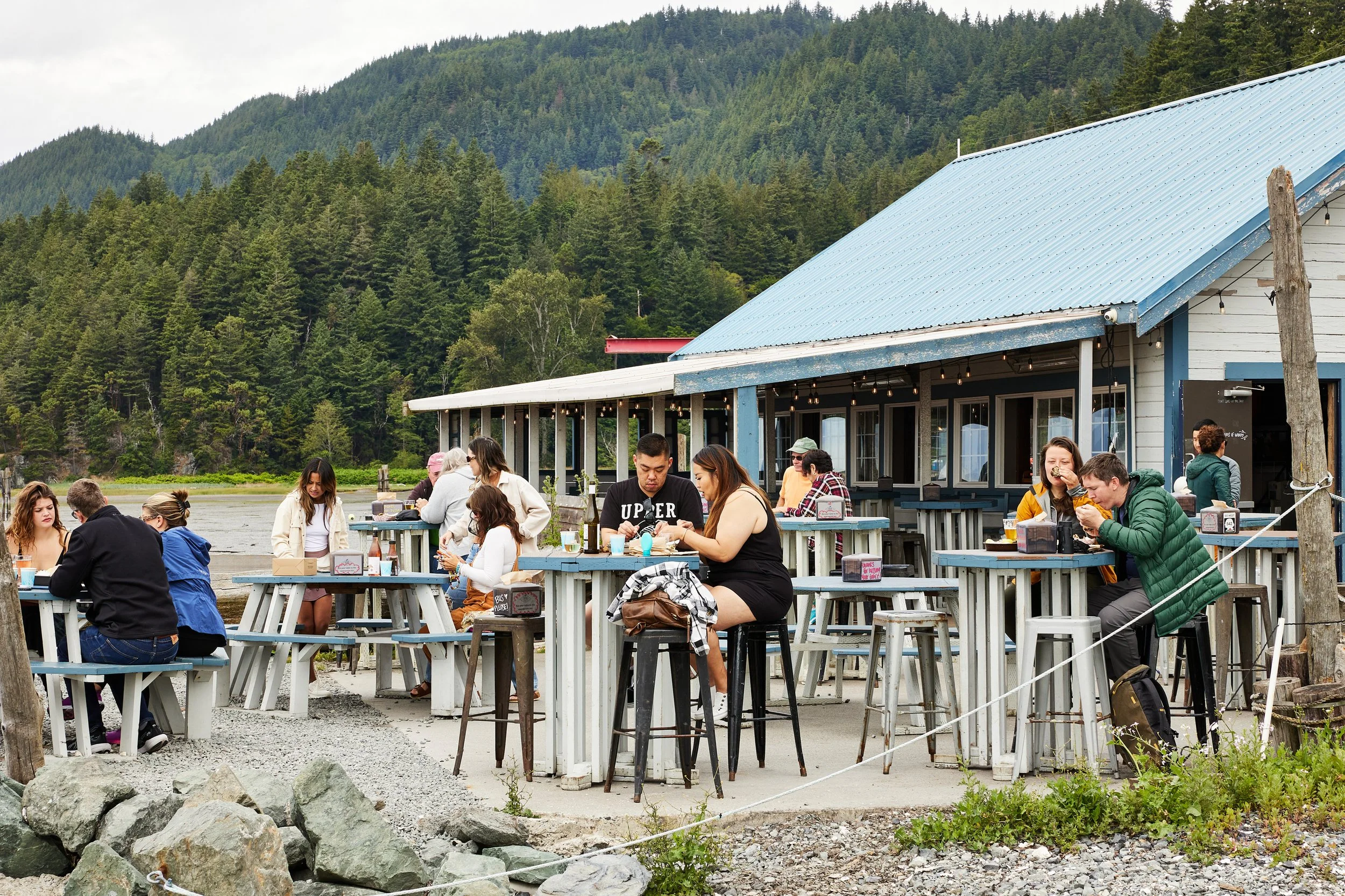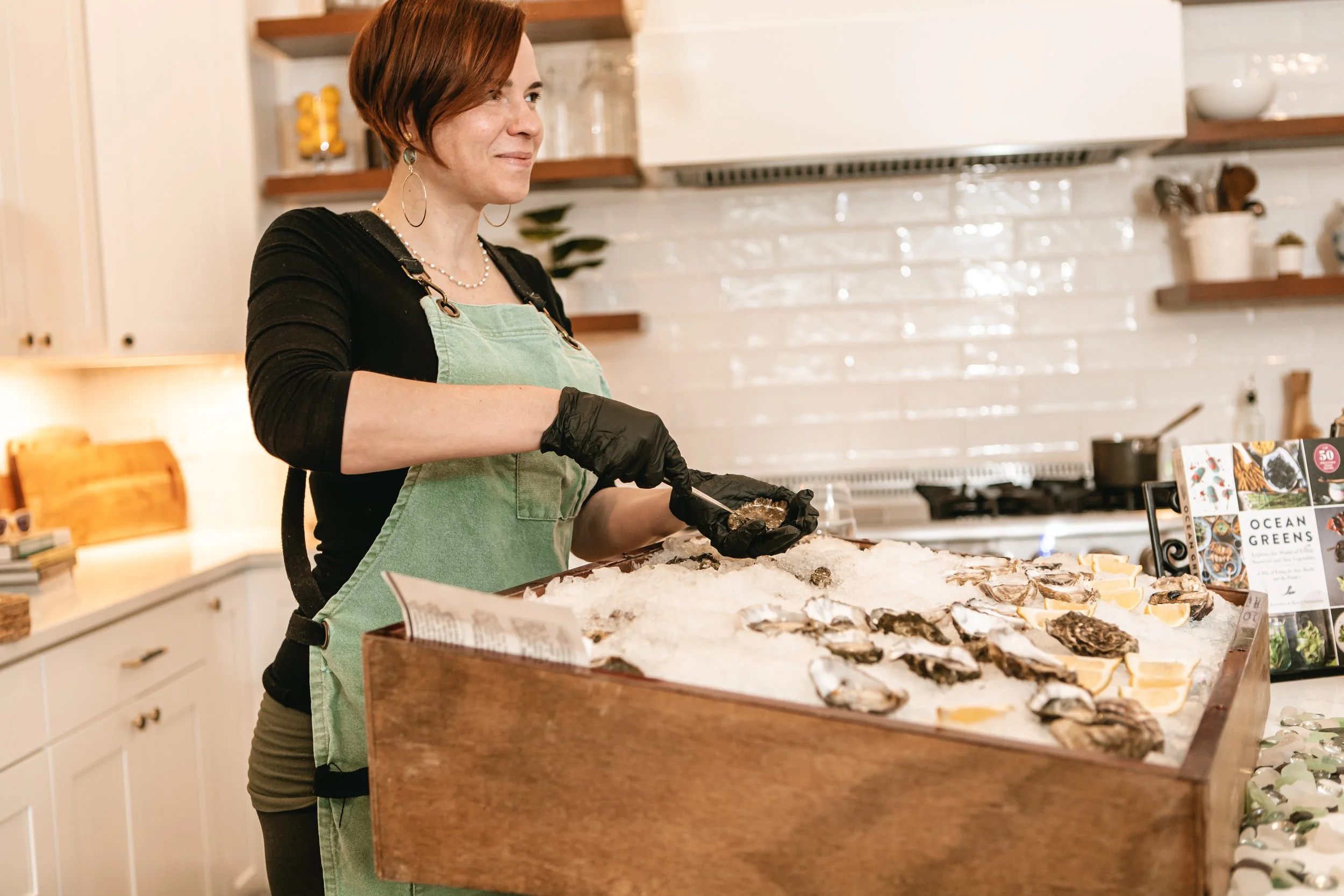a tide to table voyage
FOUR LOCAL PRODUCERS DISH ON WHAT IT TAKES TO PUT THEIR BRINY DELICACIES ON OUR PLATES.
Words by Alorie Gilbert
Photo: (left) Geoff Heith, (right) Feed It Creative
There’s nothing like a fresh, raw oyster, straight from the half-shell, for the bracing, mineral taste and texture of the sea. Puget Sound oysters, as well as clams, mussels and geoduck, have been an important food source for indigenous tribes for centuries and are a booming, dynamic industry today. They feed people around the globe while contributing to the health of the local marine environment. In honor of our region’s beloved bivalves, we’ve decided to profile a handful of local shellfish farmers in this issue of Tideland. These farmers labor tirelessly in challenging and changing conditions to satisfy our oceanic appetites.
shellfish future proofer
BAYWATER SHELLFISH COMPANY / THORNDYKE BAY, HOOD CANAL
It’s not every shellfish company that’s founded by a scientist with a PhD. But such is the case at Baywater Shellfish Company on the north end of Hood Canal. Owner Joth Davis was earning said PhD in Fisheries Sciences at University of Washington and raising a family on Bainbridge Island when he saw a road sign near the Hood Canal bridge offering tidelands for sale. “I called, and it was dirt cheap,” he recalls now, some 40 years later.Davis promptly bought 20 acres on Toandos Peninsula’s Thorndyke Bay. A few years later, he and his wife Karen grew their first crop of oysters there, launching Baywater Shellfish in 1990. Since then, the company’s signature oyster, the Baywater Sweet, has become a staple at oyster bars around the Pacific Northwest, including Seabird on Bainbridge Island. Their Indigo Sweets, cultivated in cages suspended in swift, deep water at the mouth of the Hood Canal, are another sought-after delicacy. Hood Canal, with its pronounced plankton blooms on which oysters feed, makes an ideal breeding ground, Davis notes. “It’s a fjord,” he says. “The water is deep and cold and clean and produces a type of plankton that gives oysters a sweet, fresh flavor.”
Now 70, Davis runs the company with his son Caleb, who quit his job as a bond trader 10 years ago to manage the shellfish farm. Working with his son is a delight to Davis, especially because operating the farm is just one of his gigs. Davis also works as a research biologist and affiliate professor at UW, collaborating with faculty on aquaculture research. And he’s a co-founder of Pacific Hybreed, a shellfish breeding company, as well as a science advisor to Puget Sound Restoration Fund. Oh, and he started a seaweed farm to complement his shellfish operation and investigate their natural synergies.
Both farms are field testing sites for Davis’s aquaculture research, which aims to future-proof commercial shellfish stock against ocean acidification and its corrosive effect on shellfish and other marine life. “The marriage of research and farming is very much our modus,” he explains. “We want to eventually provide the shellfish seed to help the industry thrive amidst climate change.”
The local supply of shellfish is holding steady for now though. That’s thanks to the ingenuity of growers who find “all kinds of ways to be innovative,” Davis says. They’re aided by an extensive monitoring system that scientists set up in recent years to predict the influx of corrosive coastal water, giving Washington hatcheries a chance to respond with protective measures.
Davis thrives on such challenges. “I love to observe the cycles around us that are, on one hand, constant and, on the other hand, changing due to climate, and try to figure out how my family's farm can thrive in a somewhat uncertain future,” he reflects. “I’m still working because I’m driven, to some extent, to try to make a difference.” / baywatershellfish.com
Caleb Davis runs Baywater Shellfish Company with his father Joth. (Photo: Cameron Karsten)
the standard bearer
TAYLOR SHELLFISH FARMS / SHELTON
It all began in the 1890s with the storied Olympia oyster. James Y. Waldrip, great great-grandfather of current Taylor Shellfish execs Bill and Paul Taylor, began farming the only native-to-Washington bivalve in south Puget Sound’s Totten Inlet. More than a century later, Olympia oysters are still on offer at Taylor Shellfish, as are mussels, clams, geoduck and other oyster varieties.
Shellfish aquaculture is a challenging business, and the Taylor family’s commitment to it for going-on five generations is remarkable. They’ve managed to grow and diversify, while other family-run farms have exited the industry, deterred by the hard manual labor, challenging working conditions, complex regulations and climate uncertainty. “This is a family that eats, sleeps and breathes growing shellfish,” says company spokesman Bill Dewey. “And they’re not afraid to try new things.”
The company’s tide-tumbled Shigoku oyster is an example of its innovative methods. These oysters grow in bags with floats that move up and down with the tide. The agitation results in oysters with firm, dense flesh and a deep cup. The company is also involved in a pioneering approach to cultivating oysters on floating farms in deeper water. Dewey calls floating farms “the way of the future,” as they lend themselves to mechanization, requiring less labor, and harness surface waves for the desired tumbling effect.
The Taylor family embraces its leadership role in the industry, readily mentoring and sharing knowledge with other shellfish farmers in the region. “The Taylors have always said, ‘A high tide lifts all boats,’” remarks Dewey, having just returned from a visit to fellow oyster grower Chelsea Farms. “It’s a very collaborative industry.”
For a full tide-to-table experience, dine at a Taylor Shellfish Oyster Bar in Seattle. There are three locations to choose from— Pioneer Square, Capitol Hill or Queen Anne. Or make the trek to their Samish Bay Oyster Bar and Shellfish Market in Bow, Washington, ranked among the 10 best oyster bars in America this year by Esquire. You can also shop at Taylor Shellfish markets in Shelton, Samish and online. / taylorshellfishfarms.com
Taylor Shellfish Oyster Bar and Market on Samish Bay in Bow, Washington (Photo: Feed It Creative)
kelp + oysters
SALISH SEA GREENS / BAINBRIDGE ISLAND
Among kelp’s biggest cheerleaders are friends and business partners Stephen Schreck and Talina Wood, who co-founded a kelp seasonings company in 2018. They met when Schreck, a scientific diver with a degree in Aquatic and Fisheries Sciences from University of Washington, moved to Bainbridge Island for a job at Puget Sound Restoration Fund working on wild kelp and oyster restoration. Wood, whose forebearers owned an oyster farm, grew up on Bainbridge digging for clams, shucking oysters and eating pickled bull kelp. The pair started Salish Sea Greens to turn people on to kelp’s unique flavor and build a market for a highly sustainable food source that’s native to local shores.
“It’s nice to be part of something that’s bettering the world and having a regenerative impact,” said Wood. “And I love helping people fall in love with an ingredient they aren’t familiar with.”
The company offers five kinds of kelp seasoning, including Spicy Habanero and Alderwood Smoked, and is developing additional varieties. They’re available at over 20 shops in Washington and Oregon, including Bay Hay & Feed, Willowtree Market and Millstream on Bainbridge Island.
The company also operates a mobile oyster bar, which pops up at local wineries, breweries and events, as well as at Salish Sea Greens’ island location, 8893 Three Tree Lane, every Sunday afternoon. All are great opportunities to sample and purchase the seasonings—a perfect complement to oysters. The oyster bar is available for private events as well, featuring shellfish from small, trusted suppliers located on Hood Canal, such as Set & Drift, Baywater Shellfish and Dabob Bay Oyster.
Schreck harvests oysters and kelp himself on occasion. “I get the most joy when I’m in the water harvesting and connecting to nature and knowing about the place where we’re sourcing the product,” he says.
Seaweed farming is more common on the East Coast, however, so Salish Sea Greens sourced most of it from there until recently. The company now has a Puget Sound supplier, Lummi Island Sea- Greens, and hopes to add another supplier from Vashon Island once state regulators give that operation the green light. While regulatory red tape is a hurdle for local seaweed farmers, Wood is confident that kelp is poised to take off in Washington. “Puget Sound is home to an amazing diversity of kelp—an incredible resource that’s been underutilized,” she says. “This is a young industry that has a big future ahead of it.” / salishseagreens.com
Talina Wood (above) and Stephen Schreck (left, below) run Salish Sea Greens. (Photos: (above) Jefté Sanchez, (below) Kelsey Bernert)
culinary kelp, five ways
- Try our Original blend on any stir fry. I like it with a combination of bell peppers, bok choy, and a hard boiled egg over a bed of rice.
- Use the Curry blend on top of cucumber salad made German-style, with sour cream, dill, salt, pepper and white vinegar.
- Sprinkle Alderwood Smoked Seasoning over salmon or as a topping on yukon gold potatoes seared in a cast iron with olive oil.
- Add Applewood Smoked Sea Salt to chipotle or garlic butter sauce with grilled oysters.
- Try Spicy Habanero Sea Salt on avocado toast, over white rice or as a Bloody Mary salt rim. / Stephen Schreck
steward of a legacy
MINTERBROOK OYSTER COMPANY / GIG HARBOR
Kent, who grew up in Poulsbo, now runs the company with Donna and sons Garrett and Austin, bringing the family full circle. When their sons were boys, the Kingmans harvested clams at their beachfront home on Key Peninsula and sold them to Minterbrook’s previous owners, the Wiksten family. Garrett is now head of Minterbrook operations, while Austin plans to manage a new waterfront restaurant and oyster bar near the shellfish plant, anticipated to open in 2025.
Minterbrook’s main trade is shipping premium-quality live oysters to shellfish distributors in Taiwan, Hong Kong and major U.S. cities from New York to Los Angeles. They grow several sought-after varieties, such as creamy Kumamotos and petite but potent Olympias. Minterbrook bivalves are featured on the menus of some of the most celebrated seafood establishments in the world, including Nobu. But you can load up on the briny delicacies at the Minterbrook farm store (Mon-Sat, 9 a.m.-4 p.m.).
Before the Kingmans took charge, Minterbrook was what Kent calls “a shucking house,” selling oyster and clam meat in jars. With the rising popularity of oyster bars, he decided to shift to selling live oysters, turning the shucking area into a nursery. He also introduced a unique “rejuvenation process” that returns harvested and sorted shellfish to the bay to refresh them before shipping. “It’s a more complex process,” says Kent. “But once you get it, it’s more profitable.”/ minterbrookoyster.com
Before buying Minterbrook Oyster Co., the Kingman family sold clams to its previous owners. (Photo courtesy of Minterbrook Oyster Co.)
Washington shellfish trail
The Washington Shellfish Trail, made possible by funds from the National Sea Grant Program, celebrates our region’s beloved bivalves and those dedicated to cultivating them. The trail includes farm stores, seafood markets, oyster bars, restaurants and special events from the Columbia River to the Canadian border. Below are several in your own backyard or worth a day trip.
Salty Girls Seafood Co., Sequim
A raw oyster bar, plus chowder, steamers, baked oysters,
sandwiches, salads and artisan cocktails. A women-owned
and operated business.
Tides Tavern, Gig Harbor
Offering a seafood-forward menu, including oyster shooters,
steamed clams, clam chowder and typical pub fare, in a his-
toric building on the shore of the harbor. Serving ages 21+.
The Harbor Public House, Bainbridge Island
Tuck into a cozy booth overlooking Eagle Harbor and enjoy a
bowl of chowder, clam and mussel steamers, oyster shooters,
crab rolls or fish & chips.
Seabird, Bainbridge Island
This fine dining restaurant on Bainbridge Island has added
an oyster happy hour and weekend lunch hours, as well as a
sister location, the Oyster Cellar, in downtown Seattle.
Hama Hama Oyster Co.’s Banjo Rama, Sept. 14-15
Shuck your own at this open-air party on a historic Hood
Canal oyster farm and enjoy live music, food and drink. Other
events throughout the year include foraging field trips, oyster
classes (starting in October) and farm days in the spring.
Visit the Oyster Saloon and farm store year round.
OysterFest, Shelton, Oct. 5-6
Now in its 42nd year, this two-day extravaganza attracts over
12,000 seafood enthusiasts annually with two entertainment
stages, 40+ food vendors, a microbrew garden & wine pavilion,
oyster shucking competitions and marine education exhibits.
Union City Market, Union
This rustic outpost of nearby Alderbrook Resort on Hood
Canal hosts seasonal “canal cookouts”—beach-side feasts
featuring “tide-to-trestle” dining while the sun sets behind the
Olympic Mountains. The market and its Hook & Fork
restaurant are open Thursday-Monday.
Port Madison Community Shellfish Farm, Bainbridge Island
A small, volunteer-supported farm operated by Puget Sound
Restoration Fund that promotes the benefits of a healthy
watershed through its CSA (Community Supported
Aquaculture) program. Members grow, tend, harvest and
eat oysters from the tidelands of Bloedel Reserve, with all
proceeds supporting local water quality improvement
projects and community engagement programs.






